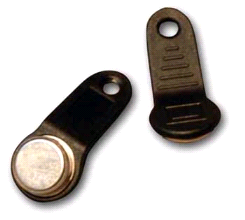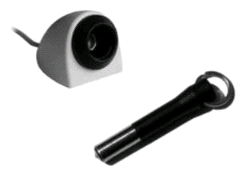operator lock
In the Peripherals tab, devices such as operator locks and transponder readers are set up and various options are activated. The operator lock is used to identify the operator at the cash register. If you use dispensing equipment or other equipment that dictates which keys are used for operator identification, you can also use one of these locks at the checkout.
With cash register systems, it is also common to log in to the cash register using a magnetic card, button or PIN. In Germany and large parts of Europe, keys are used that can also trigger an action when they are removed. With Hypersoft POS, the checkout function Key Out is used in any macro to execute it when it is deducted. Alternatively, you can set up a countdown that triggers the key out when you use logon methods without action when pulling.
Assigning operators to keys is described in the section Assign keys to operatorsto Operators.
Start the program Stationsfrom the program group System settings. Select the desired station and press the Editbutton. Select the Peripheralstab.

| Element / Switch | Function / Description |
|---|---|
|
Chip lock |
The chip lock is the standard device and recognizes the operators based on the chip keys assigned to them. For this we use chip keys which are encoded once, so that misuse due to confusion is excluded. Hypersoft supports Dallas and Addimat chip keys. Since there are also different variants here, we only guarantee for devices from our range. Picture of the Dallas chip key:
Picture Addimat lock:
Select this setting if you are using one of these chip locks. The selection Performer refers to the original chip lock from Partner Tech, which is fitted together with the magnetic card reader as standard on the cash terminal Performer. The selection Aures supports the standard chip lock of the Aures cash register (tested with type Odyssé). When using the Dallas chip lock with the standard MF2 keyboard (PC keyboard), the F6 key must be locked (not programmed otherwise). The lock should be connected serially because this is the only way to ensure reliable detection. Due to the special programming it is possible to operate more than one lock at the same time. You should check this exception with Hypersoft beforehand. |
| tag key |
The Tagkey locks from Steingress are serially connected, for this you can select the interface used. |
| WMF Lock |
The POS supports WMF locks, which read WMF operator keys (these look like ballpoint pens). |
| GrapKey | Serial or USB lock (as virtual COM port) of the Grapos dispensing systems. |
| Columbus 800 | Integrated hybrid lock of the Columbus 800. |
|
and Do not log off operator |
If the operator does not make any entries at the POS, the function Auto Key Out automatically triggers the function key at the POS on which the Key Out function is located after the set number of seconds (countdown). In addition, the cash register function Log off operator is executed. If you do not want the operator to be logged off with this, but only the process to be completed, activate the Do not log offoperator option. The start of the countdown is indicated to the operator by a progress bar in cashier mode, so that the operator can restart the countdown by pressing any element if desired. |
| QUICK Check-In |
The QUICK Check-In function is intended for cashless areas. Further documentation: Easy Check-In |
|
merge operations Activate transaction cards automatically Ignore card limit |
These are special card management settings. Please read the documentation there for details. Further documentation: Card management - settings per station |
| e-signature pad | Activates the Signature Pad. See also Configuring and Using the Pad. |
Further documentation: Auto Key Out
Back to the parent page: Hypersoft POS Connections

